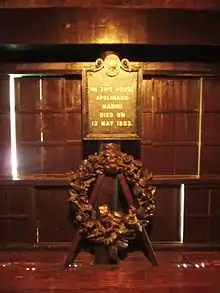Mabini Shrine (Manila)
The Mabini Shrine is a historic site in Santa Mesa, Manila, Philippines. It is the original house owned by the del Rosario family in Pandacan to whom Apolinario Mabini, known as "the Sublime Paralytic" and "the Brains of the Philippine Revolution", was related by affinity.[1] On May 13, 1903, Mabini died of cholera at the age of 39 in this house.[2] The shrine is now located within the main campus of the Polytechnic University of the Philippines in Santa Mesa, after several relocations. It is situated next to the newly-constructed Museo ni Apolinario Mabini (Apolinario Mabini Museum), where some of his belongings and memorabilia can be found. The Mabini Shrine is a government recognized National Shrine (Level 1) and cultural property based on the official lists provided by the National Commission on Culture and the Arts, National Historical Commission of the Philippines and the National Museum of the Philippines.[3]

History
The bamboo-and-nipa house was owned by Cecilio del Rosario and Maxima Castaneda-del Rosario.[4] Apolinario Mabini first lived in this house in 1888, the year he entered law school at the University of Santo Tomas. He continued to live there during most of his adult years. The original house used to be located across the river in Nagtahan, Pandacan, Manila.[5] It was moved to the south bank in 1960, into the Presidential Security Group Compound in Malacañan Park in order to give way for the widening of Nagtahan (now Mabini) Bridge. Within the compound, it was restored under the care of National Artist for Architecture, Juan F. Nakpil. In April 2007, the Metropolitan Manila Development Authority proposed that the Mabini Shrine be relocated to a new site, as part of a project to widen the river channel in order to let the water in the Pasig River flow unimpeded. Then PUP President Dr. Dante Guevarra successfully volunteered the PUP Mabini Campus as the new site, and a 905-square meter site was reserved for the shrine, hence becoming the third site of the Mabini Shrine.
The house was relocated from the Presidential Security Group compound to the Polytechnic University of the Philippines campus further up the river. The Metropolitan Manila Development Authority held a widening project along the river and decided to relocate the shrine. Dr. Dante Guevarra, the university president in 2005, welcomed the relocation of the shrine within the main campus of the Polytechnic University of the Philippines.[6] On February 8, 2010, former Philippine president Gloria Macapagal Arroyo, issued Proclamation 1992 declaring the Polytechnic University of the Philippines Mabini Campus in Santa Mesa as a permanent home of the Mabini Shrine.[7]
In order to prevent another relocation that “may further diminish its historical and architectural authenticity and sanctity as a National Shrine,” President Gloria Macapagal-Arroyo, through Proclamation No. 1992, s. 2010, declared the PUP Mabini Campus to be the permanent home of the Mabini Shrine.[8] A yearlong project was undertaken in 2013 to restore the house and its surrounding grounds.[9]
References
- "Mabini Shrine in PUP".
- "The life of Apolinario Mabini". Archived from the original on 2014-06-06.
- "National Historic Sites".
- "Briefer: Mabini Bridge and the Mabini Shrine at PUP". July 21, 2014.
- "Mabini Shrine".
- Ocampo, Ambeth. "The House where Mabini died".
- "Proclamation 1992" (PDF).
- "Proclamation No. 1992, s. 2010". Presidential Museum & Library. Retrieved June 15, 2017.
- "Briefer: Mabini Bridge and the Mabini Shrine at PUP". Presidential Museum & Library. Retrieved September 14, 2015.
Image gallery
 The marker inside the antesala room where Mabini died.
The marker inside the antesala room where Mabini died. Kitchen of the house
Kitchen of the house Antesala, or extension of the main room
Antesala, or extension of the main room Japanese table
Japanese table Mabini's convalescent chair. This is situated in the dining area.
Mabini's convalescent chair. This is situated in the dining area. Batalan
Batalan A view of the room where Mabini died.
A view of the room where Mabini died. Mabini's study area inside the antesala
Mabini's study area inside the antesala The Mabini Shrine, located inside the main campus of the Polytechnic University of the Philippines in Sta. Mesa, Manila.
The Mabini Shrine, located inside the main campus of the Polytechnic University of the Philippines in Sta. Mesa, Manila. Main room
Main room Guest room. This is where Mabini stayed.
Guest room. This is where Mabini stayed. Historical Marker installed by the National Historical Commission of the Philippines
Historical Marker installed by the National Historical Commission of the Philippines